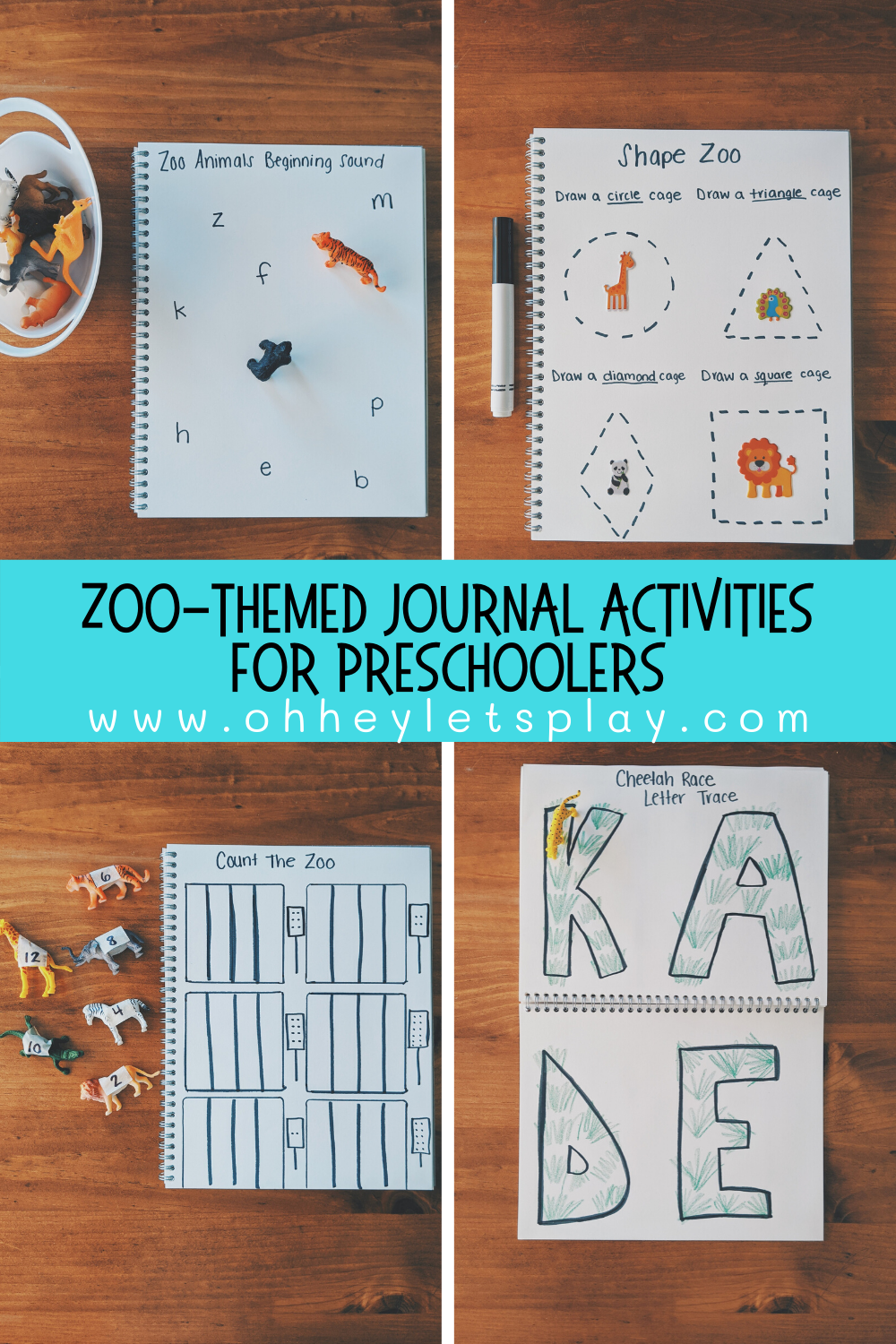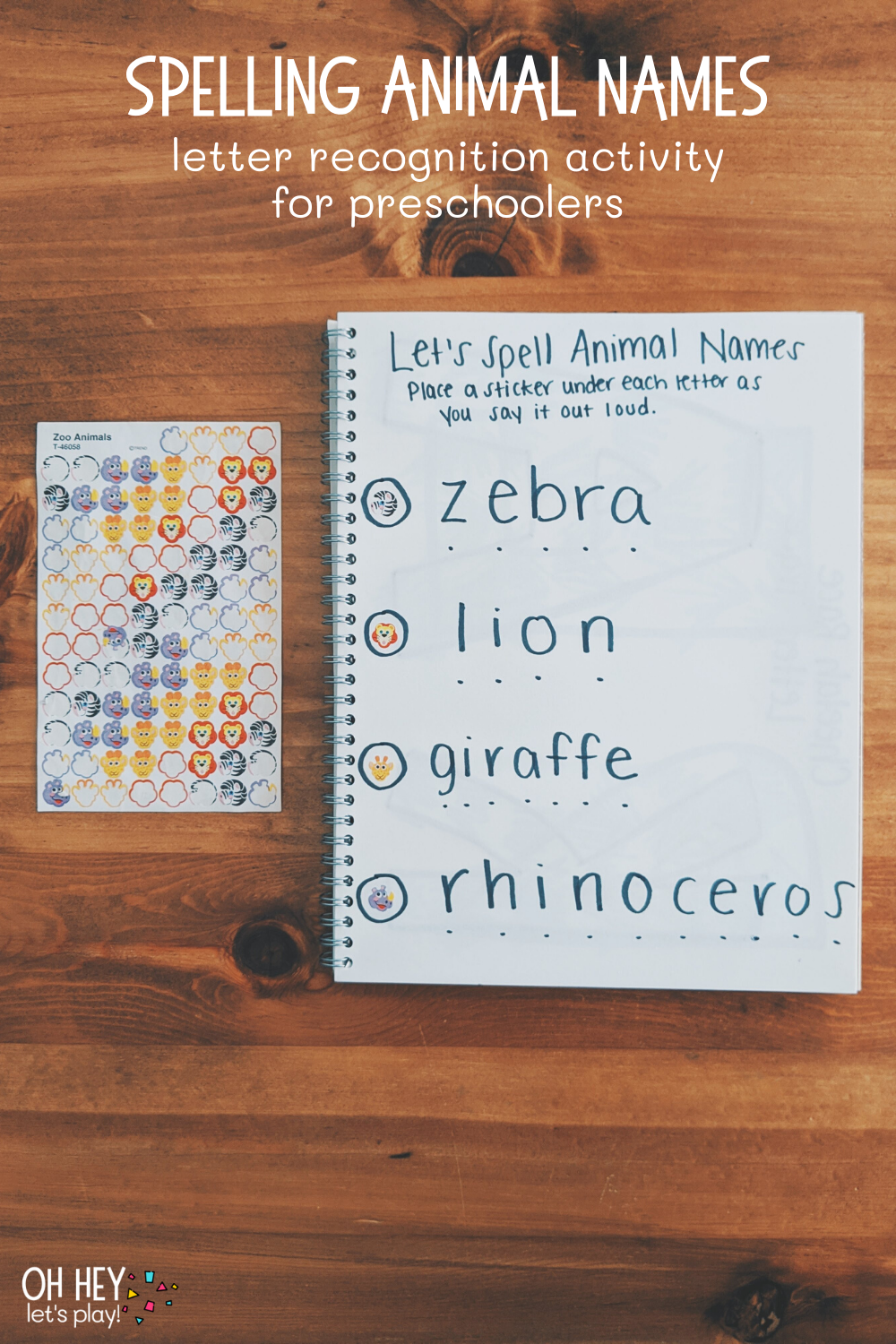Zoo-Themed Journal Activities for Preschoolers
As you may or may not know, we LOVE our learning journals. Our last journal activity post was for our 4th of July theme, but this week we are focused on all things ZOO animals. I wanted to share the 5 zoo-themed journal activities that my 4-year-old worked on this week covering skills from pre-writing, to counting and number recognition, to letter sounds, and more.
For more information about learning journals and how to start one, check out this post!
Disclaimer: This post contains affiliate links which means I would earn a small commission if you were to purchase through those links. All opinions are my own, and I only link to products that I truly recommend.
Cheetah Race Letter Trace:
All you need for this activity, aside from some markers and/or crayons for drawing up some block letters, is a little cheetah. We used the one we have from this animal set, but I’m sure there are other little cheetah friends out there somewhere. I also thought you could put a cheetah sticker on a piece of paper and cut around it, then tape it to the end of a craft stick and trace that way.
I chose to keep things simple and focus this activity around the letters in Kade’s name since he is still learning to write it. To set it up, I used a black marker and drew big block letters. For fun, I used a green crayon and added some grass to make it seem like the cheetah was running through some grasslands. If your child (or student) has a longer name, you could either make the block letters smaller and try to fit them on two pages, or you could just do a few letters on each page and just flip through them. You could also just choose a few random letters that you want them to focus on (not necessarily the ones from their name), or have them tracing numbers or shapes.
This is a great, fun way to get kiddos thinking about the formation of letters, recognizing letters, and practicing tracing. If you like this idea, and want to see more ways to practice the letters in your kids’ (or students’) names, make sure you take a peek at this post! I will also link my free printable road letters in case you have little ones who are into cars and would like to DRIVE along some letters.
Count the Zoo:
This activity was inspired by a larger version of it, by Mandisa from Happy Toddler Playtime. We shrunk it down to fit in our journal and it was perfect for zoo week! These little animals worked perfectly for so many of our activities this week. Aside from a black marker, a black sharpie, and some masking tape, they were all you needed to set this up!
I drew a few zoo cages, each with a sign next to them. Each sign had a different number of dots for Kade (4) to count. I wrote the corresponding numbers onto some tape, and stuck them each onto a different animal. The idea was that Kade would count the dots, find the corresponding number, and put that animal in its home at the zoo.
When counting the dots, kids are working on a skill called one-to-one correspondence. This means they count one number at a time for each object/dot they look at or point to (as opposed to only having counted up to 3 but already having pointed/skipped ahead 5 dots/objects). Depending on what you want your little one(s) to focus on, you could skip the dots, and just match numbers, or you could match shapes, sight words, uppercase and lowercase letters, or the letters in your kids’ or students’ names.
If you like this idea, here’s another simple counting activity we’ve done in our journal!
Spelling Animal Names:
I found these little zoo animal stickers in our stash and knew I wanted to use them somehow. I thought that spelling out the names of the animals could be a great way to practice letter recognition, discuss beginning letter sounds, work on left-to-right progression, and to help make that connection that letters work together to make a word.
All you need to set up this activity, is your black marker, and some little stickers. I put one sticker that matched the word I was going to spell out on the left-hand side of the paper to emphasize that we start on the left when reading, spelling, and writing. I wrote out the word, and put a dot underneath each letter to show where to put each sticker. Kade (4) put a sticker that matched the word (zebra stickers for the word “zebra”) underneath each letter, and I had him say each letter as he put the sticker on.
He ended up also being very observant and interested in which words had more letters than others, how many more letters one had than the other, and even started counting up how many letters each word had. I never thought to incorporate math into this activity but sometimes our kids are even smarter than we are. I said “sometimes.” ;)
I chose to write each word using lowercase letters since we need more practice on lowercase recognition than uppercase. If you don’t have stickers, but still want to try this activity out, just have your child or student use their finger to point to each dot as they say the letters. I chose to add the stickers because 1. we had them but also 2. peeling stickers is a great way to build fine motor skills.
You could use this same activity idea (with any type of little stickers) to work on spelling words, sight words, or spelling names. Instead of stickers, try it with do-a-dot markers, dabbing either on top of or right below each letter while saying them out loud.
Shape Zoo:
This activity combines pre-writing with shapes! Always a bonus when you can cover more than one skill with one simple activity. The funny thing about this activity is that I was literally ABOUT to start to draw each of those animals when I realized I was absolutely crazy to think I could do that so I searched high and low in my sticker stash to find something I could use. So thankful I came across these little guys because it was not going to be pretty. ;)
If you have skills as an artist, and drawing animals does not intimidate you, then all you need is a black marker and maybe some crayons if you want to color them in and be fancy. If you’re more like me, find some stickers- trust me. I drew a different shape (using dashed lines for tracing) around each sticker to act as their cages.
This face of concentration just kills me! He was so laser focused to stay on those lines in that moment. We are working a lot on how to hold a writing utensil and incorporating fun ways to do that and to practice writing with them is important in order to gain confidence.
Zoo Animals Beginning Sound:
I think this was my favorite journal page this week. Kade (4) gets really excited about beginning letter sounds for some reason and had a lot of fun with this. It was also literally THE EASIEST activity to prep. I chose to use all lowercase letters again just because we need more practice recognizing those than uppercase. I chose some animals that had started with letter sounds that I knew Kade would know with confidence, and then I chose a couple that I thought could be a little trickier (‘g’ for ‘gorilla,’ and ‘e’ for ‘elephant’).
We worked through some of the trickier ones together but this was a great way for Kade to practice recognizing his lowercase letters, and also thinking about the sounds each letter makes. He picked out an animal, said its name, and then together we isolated the beginning sound and tried to find the matching letter. We even worked a little bit on process of elimination- for example: when stuck on “gorilla,” I joked around with some letters I knew that he was confident in by saying “well, we know it’s not a “forilla,” and we know it’s not a “korilla” or a “borilla.” This had us both laughing together, too, which made it fun.
To access my digital learning journal guides with all my learning journal activity ideas organized by age group, check out my Digital Learning Journal Membership!
A "learning journal" is a blank sketchbook that is used to hand draw & personalize learning activities for your child based on different developmental skills. This membership makes your learning journal experience a breeze by providing you with a digital toddler, preschool, kindergarten, & early elementary aged journal activity guide. The 4 guides are organized by developmentally appropriate, seasonal & non-seasonal activities, & are frequently updated with new ideas.
In case you missed it earlier, here is the link to these little zoo animals that we used for so many of our activities this week! We used them in this fine motor activity, and in another one of our zoo activities we did this week. You can check out the rest of the zoo activities we did HERE, and be sure to also check out our ocean-themed journal activities!



















